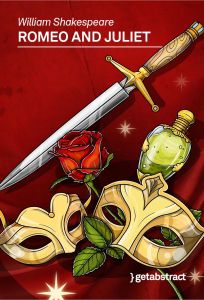
Romeo and Juliet
The Most Excellent and Lamentable Tragedy of Romeo and Juliet
- Tragedy
- Elizabethan Era
What It’s About
Star-Crossed Lovers
As one of William Shakespeare’s most enduring and successful plays during his lifetime and after, Romeo and Juliet is both a cautionary tale about the violent passion of young love and a love-poem to love itself – showing the beautiful and redemptive possibilities of the feelings Romeo and Juliet had for one another. Shakespeare perfectly interweaves the comic and the tragic, leaping from romance to playful punning to high tragedy and along the way evaluates people’s control over their own destinies. Are Romeo and Juliet indeed star-crossed? Or are they and the adults who force them to take drastic measures responsible for the play’s six tragic deaths? Though written early in Shakespeare’s career, the play’s stylistic complexity, characters’ psychological realism, and the exquisite poetry with which Romeo and Juliet express their love are a testament to the skill and humanity of a master playwright.
Summary
About the Author
William Shakespeare was baptized on April 26, 1564 in Stratford-upon-Avon, England. While little documentary evidence survives about the life of the world’s most famous playwright, he was the son of alderman and glove maker Jon Shakespeare and probably studied at the local grammar school, the King’s New School. At age 18, William married Anne Hathaway, a woman six years his senior who was pregnant with their first child, Susanna. They had two additional children – twins Hamnet and Judith; Hamnet died at age 11 in 1596. No record of Shakespeare’s activity exists for the years between 1585 and 1592, which are known as the “lost years.” But by 1592, he was residing in London and writing for the stage; contemporary poet Robert Greene disparagingly described Shakespeare as an “upstart crowe.” As of 1594, Shakespeare was a member of and wrote for Richard Burbage’s theatrical company The Lord Chamberlain’s Men. When the theaters closed due to plague in 1593, he wrote the narrative poems “The Rape of Lucrece” and “Venus and Adonis,” which were commercial hits. In 1603, when James I ascended the throne, he granted Shakespeare’s theater company royal patronage, and they became known as the King’s Men. Scholars assume that Shakespeare also acted with the company. Later in his career, Shakespeare collaborated with several other playwrights, including Thomas Middleton, George Peele and John Fletcher. Shakespeare appears to have retired to Stratford-upon-Avon around 1613, where he died on April 23, 1616, of unknown causes at age 52. He was buried in Trinity Church in his hometown. After his death, the King’s Men collected all his surviving plays – along with elegiac verses and tributes – and published them in 1623 in what is now known as the First Folio. As the author of at least 38 comic, tragic and historical plays and 154 sonnets (which were collected and published in 1609), Shakespeare is remembered as England’s greatest poet and playwright. His plays are performed worldwide to this day.








Comment on this summary